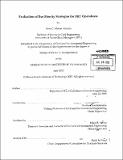Evaluation of bus priority strategies for BRT operations
Author(s)
Matías Alemán, Anna C
DownloadFull printable version (9.789Mb)
Alternative title
Evaluation of bus priority strategies for Bus Rapid Transit operations
Other Contributors
Massachusetts Institute of Technology. Department of Civil and Environmental Engineering.
Advisor
Harilaos Koutsopoulos and Mikel E. Murga.
Terms of use
Metadata
Show full item recordAbstract
Bus Rapid Transit (BRT) uses strategies such as exclusive bus lanes, off-vehicle fare collection, high quality vehicles and stations, signal priority, among others. Transit Signal Priority (TSP) is frequently seen as an option to improve performance of public transportation systems at the operational level. TSP is an operational strategy that aims at reducing the delays at intersections for transit vehicles. The goal is to reduce travel times and improve service reliability. The use of transit priority strategies, properly designed for BRT, can complement its other features and potentially contribute to improved performance. However, BRT corridors present a number of challenges and operating characteristics that differ from conventional corridors which are worth considering. This thesis evaluates the potential of incorporating different priority strategies, especially TSP, into BRT operations both in the U.S. and in developing countries. A corridor from Boston, MA and a corridor from Santiago, Chile are analyzed, assessing TSP strategies that consider different conditions such as headway, loads, and traffic demand in a BRT context. Results for both case studies support the belief that TSP can provide travel time reductions for transit vehicles, together with reductions in headway variability. However, results proved to be very sensitive to increases in traffic congestion and transit frequency. The research provides insights into the potential of TSP under medium and high levels of traffic demand, as well as under higher frequencies. Further research is necessary to make the models more robust and test the sensitivity of the parameters of the priority strategies. Evaluation of other priority strategies like the use of full exclusive bus lanes and signal coordination are also included.
Description
Thesis (S.M. in Transportation)--Massachusetts Institute of Technology, Department of Civil and Environmental Engineering, 2013. Cataloged from PDF version of thesis. Page 144 blank. Includes bibliographical references (pages 140-143).
Date issued
2013Department
Massachusetts Institute of Technology. Department of Civil and Environmental EngineeringPublisher
Massachusetts Institute of Technology
Keywords
Civil and Environmental Engineering.